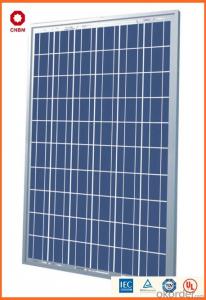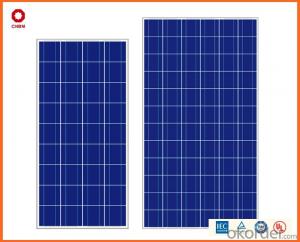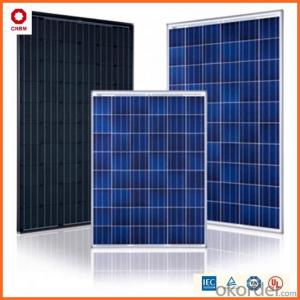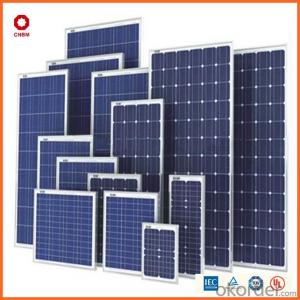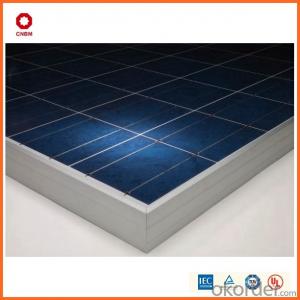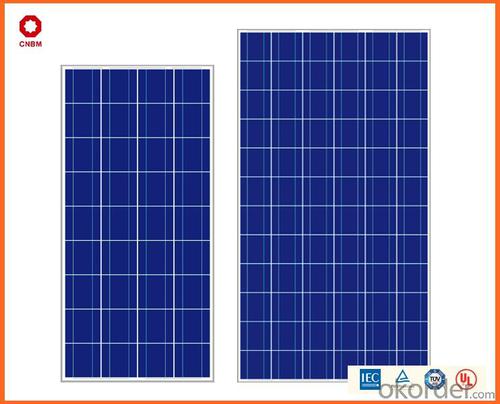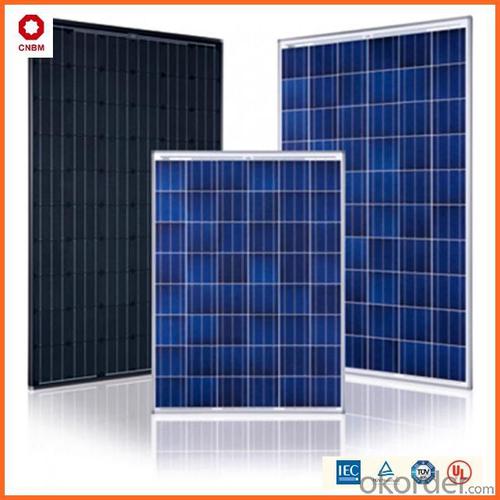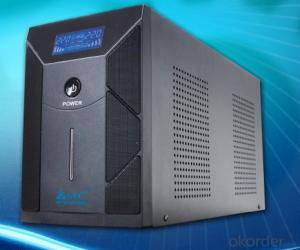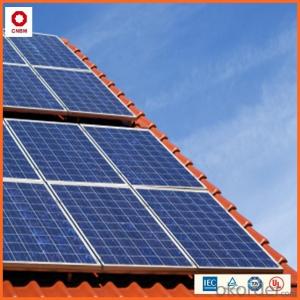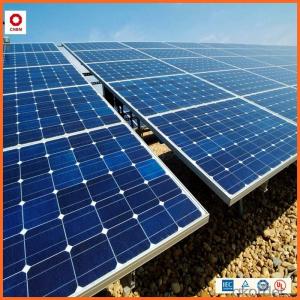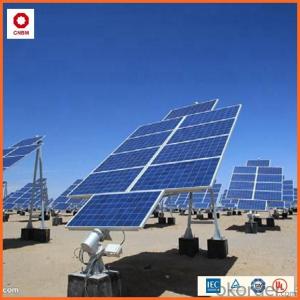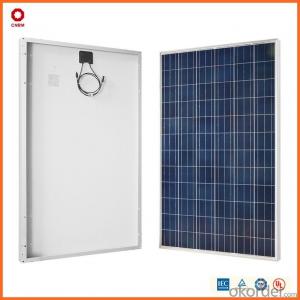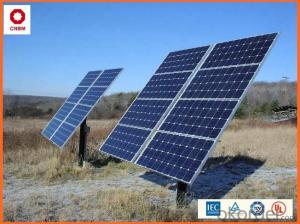Solar Energy Systems:!!! Hot on Sale!!! Stock 265W Poly Solar Panel USD0.45/W A Grade Good Solar Panel
- Loading Port:
- China main port
- Payment Terms:
- TT OR LC
- Min Order Qty:
- 1 watt
- Supply Capability:
- 10000000 watt/month
OKorder Service Pledge
OKorder Financial Service
You Might Also Like
Product Description:
Hot Sale !!! Quality and Safety of 245w-320w Poly Solar Panel
1. Rigorous quality control meets the highest international standards.
2. High-transmissivity low-iron tempered glass, strong aluminium frame.
3. Using UV-resistant silicon.
4. IS09001/14001/CE/TUV/UL
Warranties of 245w-320w Poly Solar Panel
1. 10 years limited product warranty
2. 15 years at 90% of the minimal rated power output
3. 25 years at 80% of the minimal rated power output
Technical date of 245w-320w Poly Solar Panel
ITEM NO.: | Mono 125*125 cell ,36pcs . Power range from 80Wp-100Wp | ||||||||
Maximum Power(W) | 80 | 85 | 90 | 95 | 100 | ||||
Optimum Power Voltage(Vmp) | 17.81 | 17.89 | 17.94 | 17.99 | 18.06 | ||||
Optimum Operatige Current(Imp) | 4.78 | 4.91 | 5.12 | 5.35 | 5.59 | ||||
Open Circuit Voltage(Voc) | 21.98 | 22.05 | 22.14 | 22.28 | 22.45 | ||||
Short Circuit Current(Isc) | 4.95 | 5.15 | 5.36 | 5.65 | 5.84 | ||||
Solar Cell: | 125*125 Mono | ||||||||
Number of Cell(pcs) | 4*9 | ||||||||
Brand Name of Solar Cells | JA Cell, Bluesun Cell | ||||||||
Size of Module(mm) | 1580*808*35 | ||||||||
Caple & Connector Type | Pass the TUV Certificate | ||||||||
Frame(Material Corners,etc.) | Aluminium-alloy | ||||||||
Backing (Brand Type) | TPT | ||||||||
Cell Efficiency for 100W(%) | 15.8% | ||||||||
Weight Per Piece(KG) | 12.0KG | ||||||||
FF (%) | 70-76% | ||||||||
Junction Box Type | Pass the TUV Certificate | ||||||||
Tolerance Wattage(e.g.+/-5%) | ±3%, or 0-3% | ||||||||
Front Glass Thikness(mm) | 3.2 | ||||||||
Temperature Coefficients of Isc(%) | +0.04 | ||||||||
Temperature Coefficients of Voc(%) | -0.38 | ||||||||
Temperature Coefficients of Pm(%) | -0.47 | ||||||||
Temperature Coefficients of Im(%) | +0.04 | ||||||||
Temperature Coefficients of Vm(%) | -0.38 | ||||||||
Temperature Range | -40°C to +85°C | ||||||||
Surface Maximum Load Capacity | 2400Pa | ||||||||
Allowable Hail Load | 23m/s ,7.53g | ||||||||
Bypass Diode Rating(A) | 12 | ||||||||
Warranty | 90% of 10 years,80% of 25 years. | ||||||||
Standard Test Conditions | AM1.5 1000W/ 25 +/-2°C | ||||||||
Packing | carton or pallet | ||||||||
1*20' | 25 Pallets / 450pcs | ||||||||
1*40'STD | 25 Pallets / 100pcs | ||||||||
Features of our products:
• High conversion efficiency mono/poly-crystalline amorphous silicon solar cells
• Modules incorporate high performance bypass diodes to minimize the power drop caused by shading
• High transmittance, low-iron tempered glass
• High performance EVA encapsulant to prevent destroying and water.
• AI frame: without screw, corner connection. 8 holes on the frame can be installed easily
• Good performance of preventing from atrocious weather such as wind and hails
• Certifications: CE IEC TUV VDE UL, Class I
• 10 years 90% power output warranty

Shipping of 245w-320w Poly Solar Panel
By Sea | Delivery from Shanghai or Ningbo seaport |
By Air | Departure from Shanghai Pudong Airport |
By Express | Post by DHL, EMS, UPS, TNT. |
- Q: Can solar energy systems be used for powering drones?
- Yes, solar energy systems can be used for powering drones. Solar panels can be installed on the surface of the drones to capture sunlight and convert it into electrical energy, which can then be used to power the drone's motors and other components. This allows drones to have longer flight times, reduced reliance on traditional batteries, and a more sustainable and environmentally friendly power source.
- Q: How long do solar energy systems last?
- Solar energy systems typically have a lifespan of 25 to 30 years, but with proper maintenance and care, some components can last even longer.
- Q: Can solar energy systems be used in powering mining operations?
- Yes, solar energy systems can be used to power mining operations. Solar panels can be installed near mining sites to capture sunlight and convert it into electricity, which can then be used to power various equipment and machinery required for mining operations. This helps reduce dependence on fossil fuels, lowers operational costs, and minimizes environmental impact associated with traditional power sources.
- Q: How do solar energy systems affect carbon footprint?
- Solar energy systems have a positive impact on carbon footprint as they harness the power of the sun, a renewable and clean energy source, to generate electricity. By reducing reliance on fossil fuels, solar energy systems significantly decrease carbon dioxide emissions and other greenhouse gases, thereby helping to mitigate climate change and reduce our overall carbon footprint.
- Q: Can solar energy systems be used in areas with limited space?
- Yes, solar energy systems can be used in areas with limited space. With advancements in solar technology, there are various compact and flexible solar panels available that can be easily installed in small spaces such as rooftops, balconies, or even on walls. Additionally, solar energy systems can also be integrated into existing structures, like windows or building facades, to maximize space utilization.
- Q: Can solar energy systems be used in powering scientific research vessels or marine laboratories?
- Yes, solar energy systems can be used to power scientific research vessels or marine laboratories. Solar panels can be installed on the vessels or on nearby platforms to harness sunlight and convert it into electricity, which can then be used to power various equipment and systems onboard, such as navigation devices, communication systems, lighting, and scientific instruments. This not only reduces reliance on fossil fuels but also provides a sustainable and renewable energy source for these facilities, enabling them to operate efficiently and environmentally responsibly.
- Q: What is the role of solar-powered ventilation systems in solar energy systems?
- The role of solar-powered ventilation systems in solar energy systems is to regulate and optimize the airflow within a building or structure by using solar energy to power the ventilation system. These systems help in maintaining a comfortable and healthy indoor environment by ventilating and circulating fresh air while reducing the reliance on traditional energy sources. Additionally, solar-powered ventilation systems contribute to the overall efficiency and sustainability of solar energy systems by utilizing renewable energy and reducing carbon emissions associated with conventional ventilation systems.
- Q: Can solar energy systems be used in conjunction with backup generators?
- Yes, solar energy systems can be used in conjunction with backup generators. This combination allows for a reliable and uninterrupted power supply, as solar panels can generate electricity during the day while excess energy can be stored in batteries or fed back into the grid. Backup generators can then be used as a secondary power source during periods of low solar generation or in case of emergencies.
- Q: Can solar energy systems be used for powering off-grid cabins?
- Yes, solar energy systems can be used to power off-grid cabins. Solar panels can be installed on the roof or in a sunny location near the cabin to capture sunlight and convert it into electricity. This electricity can then be stored in batteries for use during periods of low sunlight or at night. With advancements in technology, solar energy systems have become an efficient and reliable option for powering off-grid cabins, providing a sustainable and renewable energy source.
- Q: Do solar energy systems require a backup battery system?
- Solar energy systems do not necessarily require a backup battery system, but it can be beneficial to have one depending on your specific needs and circumstances. Solar energy systems generate electricity from the sun and can be connected to the grid, allowing excess energy to be sold back to the utility company. This means that during times when the sun is not shining, such as at night or during cloudy weather, you can still draw electricity from the grid. However, having a backup battery system can provide several advantages. First, it allows you to store excess energy generated during the day for use at night or during power outages. This can provide you with a reliable source of electricity even when the grid is down. Additionally, a backup battery system can provide a more consistent power supply. When connected to the grid, solar energy systems typically shut down during power outages to ensure the safety of utility workers. With a backup battery system, you can continue to power your essential appliances and devices during these outages. Furthermore, having a backup battery system can provide energy independence. By storing your own energy, you can reduce reliance on the grid and potentially offset the cost of electricity bills even further. Ultimately, the decision to install a backup battery system for a solar energy system depends on your specific energy needs, budget, and preferences. Consulting with a solar energy professional can help you determine the best solution for your situation.
Send your message to us
Solar Energy Systems:!!! Hot on Sale!!! Stock 265W Poly Solar Panel USD0.45/W A Grade Good Solar Panel
- Loading Port:
- China main port
- Payment Terms:
- TT OR LC
- Min Order Qty:
- 1 watt
- Supply Capability:
- 10000000 watt/month
OKorder Service Pledge
OKorder Financial Service
Similar products
Hot products
Hot Searches
Related keywords
